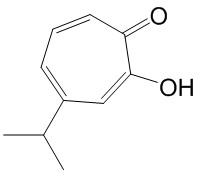Home
Products
Hinokitiol



| Product Name | Hinokitiol |
| Price: | $28 / 20mg |
| Catalog No.: | CN03724 |
| CAS No.: | 499-44-5 |
| Molecular Formula: | C10H12O2 |
| Molecular Weight: | 164.2 g/mol |
| Purity: | >=98% |
| Type of Compound: | Phenols |
| Physical Desc.: | Powder |
| Source: | The herbs of Platycladus orientalis |
| Solvent: | Chloroform, Dichloromethane, Ethyl Acetate, DMSO, Acetone, etc. |
| SMILES: | CC(c1cccc(=O)c(c1)O)C |
| Contact us | |
|---|---|
| First Name: | |
| Last Name: | |
| E-mail: | |
| Question: | |
| Description | Hinokitiol is a component of essential oils isolated from Chymacyparis obtusa, reduces Nrf2 expression, and decreases DNMT1 and UHRF1 mRNA and protein expression, with anti-infective, anti-oxidative, and anti-tumor activities. |
| Target | DNMT1 Nrf2 |
| In Vitro | In U87MG and T98G glioma cell lines, hinokitiol demonstrates a dose-dependent decrease in viability, with IC50 values of 316.5 ± 35.5 and 152.5 ± 25.3 µM, respectively. Hinokitiol represses ALDH activity and self-renewal ability in glioma stem cells, and inhibits in vitro oncogenicity. Hinokitiol also reduces Nrf2 expression in glioma stem cells in a dose-dependent manner[1]. Hinokitiol (0-100 μM) inhibits colon cancer cell growth in a dose- and time-dependent manner. Hinokitiol (5, 10 μM) decreases DNMT1 and UHRF1 mRNA and protein expression, and increases TET1 expression via enhancement of 5hmC level in HCT-116 cells. Furthermore, hinokitiol reduces methylation status and restores mRNA expression of MGMT, CHST10, and BTG4 genes[2]. |
| Cell Assay | U87MG and T98G glioma cells are cultured in Dulbecco's modified Eagle's medium with Ham's F12 medium (DMEM/F-12) containing 10% fetal bovine serum. Cell viability is determined using MTT to evaluate the cytotoxicity of hinokitiol. Cells are seeded in 24-well plates (1×105 cells/well) in the presence of various concentration of hinokitiol or vehicle at 37°C for 24 h followed by incubation with MTT reagent. The blue formazan crystals of viable cells are dissolved in DMSO and then evaluated spectrophotometrically at 570 nm. DMSO-treated group is set as 100%, and data are presented as percentage of DMSO control. IC50 values are calculated by the GraFit software. |
| Density | 1.1±0.1 g/cm3 |
| Boiling Point | 303.4±35.0 °C at 760 mmHg |
| Flash Point | 128.1±18.5 °C |
| Exact Mass | 164.083725 |
| PSA | 37.30000 |
| LogP | 1.89 |
| Vapour Pressure | 0.0±1.4 mmHg at 25°C |